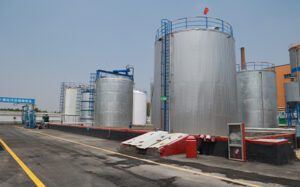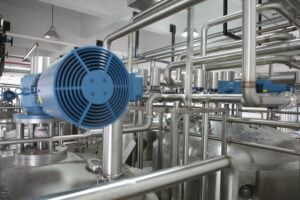Filtration is a critical process in various industries, from pharmaceuticals to water treatment. Choosing the right filtration material can significantly impact the efficiency and effectiveness of the process. Polyvinylidene difluoride (PVDF) has gained recognition as an exceptional choice for filtration applications. In this comprehensive guide, we will explore the numerous advantages of PVDF in filtration, highlighting its unique properties, versatility, and why it has become a preferred material in the world of separation and purification.
1. Introduction to PVDF

Polyvinylidene difluoride, commonly known as PVDF, is a synthetic polymer with a unique molecular structure. Its chemical formula, (CH2CF2)n, consists of repeating units of vinylidene difluoride. PVDF’s exceptional properties have made it a sought-after material in various industrial applications, including filtration.
2. The Key Properties of PVDF
Before delving into the advantages of PVDF in filtration, let’s explore the fundamental properties that set it apart:
2.1. Chemical Resistance
PVDF exhibits exceptional chemical resistance, making it impervious to a wide range of corrosive chemicals, acids, and bases. This property ensures the integrity of the filtration process even in harsh environments.
2.2. Mechanical Strength
PVDF is known for its robust mechanical properties, including high tensile strength and resistance to wear and tear. This strength is crucial in maintaining the structural integrity of filtration systems.
2.3. Thermal Stability
With a melting point between 160-170°C (320-338°F), PVDF can withstand elevated temperatures, making it suitable for filtration processes that involve heat.
2.4. Hydrophobic Nature
PVDF is inherently hydrophobic, repelling water and allowing for efficient filtration of aqueous solutions.
2.5. Pore Size Control
PVDF membranes can be engineered with precise pore sizes, enabling fine-tuned filtration and separation based on particle or molecule size.
3. Advantages of PVDF in Filtration
3.1. Exceptional Chemical Compatibility
PVDF’s resistance to a wide range of chemicals makes it suitable for filtration in industries handling corrosive substances. It remains stable and does not degrade even when exposed to aggressive solvents and acids.
3.2. High Purity Filtration
PVDF membranes provide high-purity filtration, ensuring that contaminants, particles, and impurities are effectively removed from the process fluid. This is crucial in applications like pharmaceutical manufacturing and biotechnology.
3.3. Wide pH Range
PVDF can operate across a broad pH range, making it versatile for both acidic and alkaline filtration processes. This adaptability extends its use in various industries.
3.4. Thermal Resistance
PVDF’s thermal stability allows it to endure high-temperature filtration processes, such as sterilization or heat-based separation techniques, without compromising its performance.
3.5. Hydrophobic Properties
The hydrophobic nature of PVDF is advantageous in separating water from organic solvents or in filtration processes where water interference is undesirable.
3.6. Longevity and Durability
PVDF filtration membranes are known for their durability and longevity. They can withstand continuous use and maintain their filtration efficiency over extended periods.
4. PVDF in Liquid Filtration
4.1. Pharmaceutical Filtration
PVDF is extensively used in pharmaceutical manufacturing for sterile filtration, ensuring the removal of microorganisms and particles from drugs and parenteral solutions.
4.2. Food and Beverage Industry
In the food and beverage sector, PVDF filtration is employed for the clarification and purification of beverages, including juices and wine, as well as the removal of bacteria and contaminants.
5. PVDF in Air and Gas Filtration
5.1. Industrial Gas Filtration
PVDF’s chemical resistance and high-temperature tolerance make it suitable for filtering industrial gases, such as corrosive gases in semiconductor manufacturing.
5.2. Cleanroom Applications
PVDF filters are used in cleanrooms to maintain sterile environments by removing airborne contaminants and particulates.
6. Applications of PVDF Filtration
PVDF filtration is integral to a wide range of applications:
- Biotechnology: PVDF is used for the sterile filtration of biopharmaceuticals and vaccines.
- Environmental Monitoring: It aids in monitoring air and water quality by capturing pollutants and particles.
- Chemische Verarbeitung: PVDF filtration ensures the purity of chemicals and solvents in manufacturing processes.
- Öl und Gas: In the oil and gas industry, PVDF filters are used for the removal of impurities from drilling fluids and process fluids.
- Elektronik: PVDF filters protect electronic components from contamination in cleanrooms and manufacturing processes.
7. Frequently Asked Questions (FAQ)
Q1: How does PVDF compare to other filtration materials like PTFE?
PVDF offers advantages such as superior chemical resistance and a wider pH range compared to materials like PTFE (polytetrafluoroethylene). The choice between them depends on the specific needs of the filtration application.
Q2: Is PVDF filtration suitable for high-temperature processes?
Yes, PVDF’s thermal stability makes it suitable for high-temperature filtration processes, including sterilization and hot liquid filtration.
Q3: Can PVDF membranes be customized for specific filtration needs?
Yes, PVDF membranes can be engineered with precise pore sizes and configurations to meet the specific requirements of different filtration applications.
Q4: Is PVDF filtration used in water treatment?
Yes, PVDF filtration is employed in water treatment processes for removing contaminants and providing clean, potable water.
Q5: What makes PVDF a sustainable choice for filtration?
PVDF’s durability and longevity contribute to sustainability by reducing the need for frequent membrane replacement, minimizing waste, and optimizing filtration efficiency.
In conclusion, Polyvinylidene difluoride (PVDF) has cemented its place as a premier material in filtration applications across various industries. Its exceptional chemical resistance, mechanical strength, thermal stability, and hydrophobic properties make it an ideal choice for high-purity and high-performance filtration processes. As industries continue to prioritize efficiency and reliability in their filtration systems, PVDF’s advantages will undoubtedly play a significant role in shaping the future of separation and purification processes.



